RT-4M: Real-Time Mosaicing Manager for Manual Microscopy System
Abstract
1. Introduction
2. Materials and Methods
2.1. System Architecture
2.2. Details of Registration Stage
2.3. Details of Composition Stage
2.4. Sample Preparation
2.5. Imaging
2.6. Performance Evaluation
3. Results
3.1. Creation of Virtual Slides of Various Samples
3.2. Comparison with Automated Microscopy and Slide Scanner
3.3. Performance Evaluation of Additional Matching During Registration
3.4. Performance Evaluation of Distortion Correction in Composition Stage
3.5. Comparison with Other Software
4. Discussion
Supplementary Materials
Author Contributions
Funding
Institutional Review Board Statement
Informed Consent Statement
Data Availability Statement
Acknowledgments
Conflicts of Interest
Abbreviations
| FFPE | Formalin-fixed paraffin-embedded |
| FOV | Field-of-view |
| HE | Hematoxylin and eosin |
| PDAC | Pancreatic ductal adenocarcinoma |
| RMS | Root mean square |
| RT-4M | Real-time mosaicing manager for manual microscopy system |
References
- Pantanowitz, L.; Valenstein, P.N.; Evans, A.J.; Kaplan, K.J.; Pfeifer, J.D.; Wilbur, D.C.; Collins, L.C.; Colgan, T.J. Review of the Current State of Whole Slide Imaging in Pathology. J. Pathol. Inform. 2011, 2, 36. [Google Scholar] [CrossRef] [PubMed]
- Hörl, D.; Rojas Rusak, F.; Preusser, F.; Tillberg, P.; Randel, N.; Chhetri, R.K.; Cardona, A.; Keller, P.J.; Harz, H.; Leonhardt, H.; et al. BigStitcher: Reconstructing High-Resolution Image Datasets of Cleared and Expanded Samples. Nat. Methods 2019, 16, 870–874. [Google Scholar] [CrossRef]
- Chalfoun, J.; Majurski, M.; Blattner, T.; Bhadriraju, K.; Keyrouz, W.; Bajcsy, P.; Brady, M. MIST: Accurate and Scalable Microscopy Image Stitching Tool with Stage Modeling and Error Minimization. Sci. Rep. 2017, 7, 4988. [Google Scholar] [CrossRef]
- Bria, A.; Iannello, G. TeraStitcher—A Tool for Fast Automatic 3D-Stitching of Teravoxel-Sized Microscopy Images. BMC Bioinform. 2012, 13, 316. [Google Scholar] [CrossRef]
- Zukić, D.; Jackson, M.; Dimiduk, D.; Donegan, S.; Groeber, M.; McCormick, M. ITKMontage: A Software Module for Image Stitching. Integr. Mater. Manuf. Innov. 2021, 10, 115–124. [Google Scholar] [CrossRef]
- Brown, M.; Lowe, D.G. Recognising Panoramas. Proc. IEEE Int. Conf. Comput. Vis. 2003, 2, 1218–1225. [Google Scholar] [CrossRef]
- Szeliski, R. Image Alignment and Stitching: A Tutorial. Found. Trends® Comput. Graph. Vis. 2007, 2, 1–104. [Google Scholar] [CrossRef]
- Pellikka, M.; Lahtinen, V. A Robust Method for Image Stitching. Pattern Anal. Appl. 2021, 24, 1847–1858. [Google Scholar] [CrossRef]
- Mohammadi, F.S.; Mohammadi, S.E.; Mojarad Adi, P.; Mirkarimi, S.M.A.; Shabani, H. A Comparative Analysis of Pairwise Image Stitching Techniques for Microscopy Images. Sci. Rep. 2024, 14, 9215. [Google Scholar] [CrossRef]
- Piccinini, F.; Bevilacqua, A.; Lucarelli, E. Automated Image Mosaics by Non-automated Light Microscopes: The MicroMos Software Tool. J. Microsc. 2013, 252, 226–250. [Google Scholar] [CrossRef]
- Preibisch, S.; Saalfeld, S.; Tomancak, P. Globally Optimal Stitching of Tiled 3D Microscopic Image Acquisitions. Bioinformatics 2009, 25, 1463–1465. [Google Scholar] [CrossRef] [PubMed]
- Ma, B.; Zimmermann, T.; Rohde, M.; Winkelbach, S.; He, F.; Lindenmaier, W.; Dittmar, K.E.J. Use of Autostitch for Automatic Stitching of Microscope Images. Micron 2007, 38, 492–499. [Google Scholar] [CrossRef]
- Banavar, S.R.; Chippagiri, P.; Pandurangappa, R.; Annavajjula, S.; Rajashekaraiah, P.B. Image Montaging for Creating a Virtual Pathology Slide: An Innovative and Economical Tool to Obtain a Whole Slide Image. Anal Cell Pathol 2016, 2016, 9084909. [Google Scholar] [CrossRef] [PubMed]
- Gherardi, A.; Bevilacqua, A. Real-Time Whole Slide Mosaicing for Non-Automated Microscopes in Histopathology Analysis. J. Pathol. Inform. 2013, 4, S9. [Google Scholar] [CrossRef]
- He, H.; Yang, H.; Mercaldo, F.; Santone, A.; Huang, P. Isolation Forest-Voting Fusion-Multioutput: A Stroke Risk Classification Method Based on the Multidimensional Output of Abnormal Sample Detection. Comput. Methods Programs Biomed. 2024, 253, 108255. [Google Scholar] [CrossRef]
- Huang, P.; Xiao, H.; He, P.; Li, C.; Guo, X.; Tian, S.; Feng, P.; Chen, H.; Sun, Y.; Mercaldo, F.; et al. LA-ViT: A Network With Transformers Constrained by Learned-Parameter-Free Attention for Interpretable Grading in a New Laryngeal Histopathology Image Dataset. IEEE J. Biomed. Health Inf. 2024, 28, 3557–3570. [Google Scholar] [CrossRef]
- Huang, P.; Li, C.; He, P.; Xiao, H.; Ping, Y.; Feng, P.; Tian, S.; Chen, H.; Mercaldo, F.; Santone, A.; et al. MamlFormer: Priori-Experience Guiding Transformer Network via Manifold Adversarial Multi-Modal Learning for Laryngeal Histopathological Grading. Inf. Fusion 2024, 108, 102333. [Google Scholar] [CrossRef]
- Bradski, G. The OpenCV Library. Dr. Dobb’s J. Softw. Tools 2000. Available online: https://www.scirp.org/reference/ReferencesPapers?ReferenceID=1692176 (accessed on 1 April 2025).
- Agarwal, S.; Mierle, K. The Ceres Solver Team Ceres Solver. Available online: http://ceres-solver.org/ (accessed on 1 April 2025).
- Lowe, D.G. Object Recognition from Local Scale-Invariant Features. In Proceedings of the Seventh IEEE International Conference on Computer Vision, Kerkyra, Greece, 20–27 September 1999; Volume 2, pp. 1150–1157. [Google Scholar]
- Alcantarilla, P.F.; Solutions, T. Fast Explicit Diffusion for Accelerated Features in Nonlinear Scale Spaces. IEEE Trans. Pattern Anal. Mach. Intell. 2011, 34, 1281–1298. [Google Scholar]
- Rublee, E.; Rabaud, V.; Konolige, K.; Bradski, G. ORB: An Efficient Alternative to SIFT or SURF. In Proceedings of the 2011 International Conference on Computer Vision, Barcelona, Spain, 6–13 November 2011; pp. 2564–2571. [Google Scholar]
- Leutenegger, S.; Chli, M.; Siegwart, R.Y. BRISK: Binary Robust Invariant Scalable Keypoints. In Proceedings of the 2011 International Conference on Computer Vision, Barcelona, Spain, 6–13 November 2011; pp. 2548–2555. [Google Scholar]
- Alcantarilla, P.F.; Bartoli, A.; Davison, A.J. KAZE Features. In Proceedings of the Computer Vision–ECCV 2012: 12th European Conference on Computer Vision, Florence, Italy, 7–13 October 2012; Proceedings, Part VI 12. Springer: Berlin/Heidelberg, Germany, 2012; pp. 214–227. [Google Scholar]
- Levenberg, K. A Method for the Solution of Certain Non-Linear Problems in Least Squares. Q. Appl. Math. 1944, 2, 164–168. [Google Scholar] [CrossRef]
- Heikkila, J.; Silvén, O. A Four-Step Camera Calibration Procedure with Implicit Image Correction. In Proceedings of the IEEE Computer Society Conference on Computer Vision and Pattern Recognition, San Juan, PR, USA, 17–19 June 1997; pp. 1106–1112. [Google Scholar]
- Mori, N.; Akagi, Y.; Imai, Y.; Takayama, Y.; Kida, Y.S. Fabrication of Perfusable Vascular Channels and Capillaries in 3D Liver-like Tissue. Sci. Rep. 2020, 10, 5646. [Google Scholar] [CrossRef] [PubMed]
- Pech-Pacheco, J.L.; Cristobal, G.; Chamorro-Martinez, J.; Fernandez-Valdivia, J. Diatom Autofocusing in Brightfield Microscopy: A Comparative Study. In Proceedings of the 15th International Conference on Pattern Recognition, ICPR-2000, Barcelona, Spain, 3–7 September 2000; Volume 3, pp. 314–317. [Google Scholar]
- Mir, H.; Xu, P.; Van Beek, P. An Extensive Empirical Evaluation of Focus Measures for Digital Photography. In Proceedings of the IS&T/SPIE Electronic Imaging, San Francisco, CA, USA, 7 March 2014; p. 90230I. [Google Scholar]
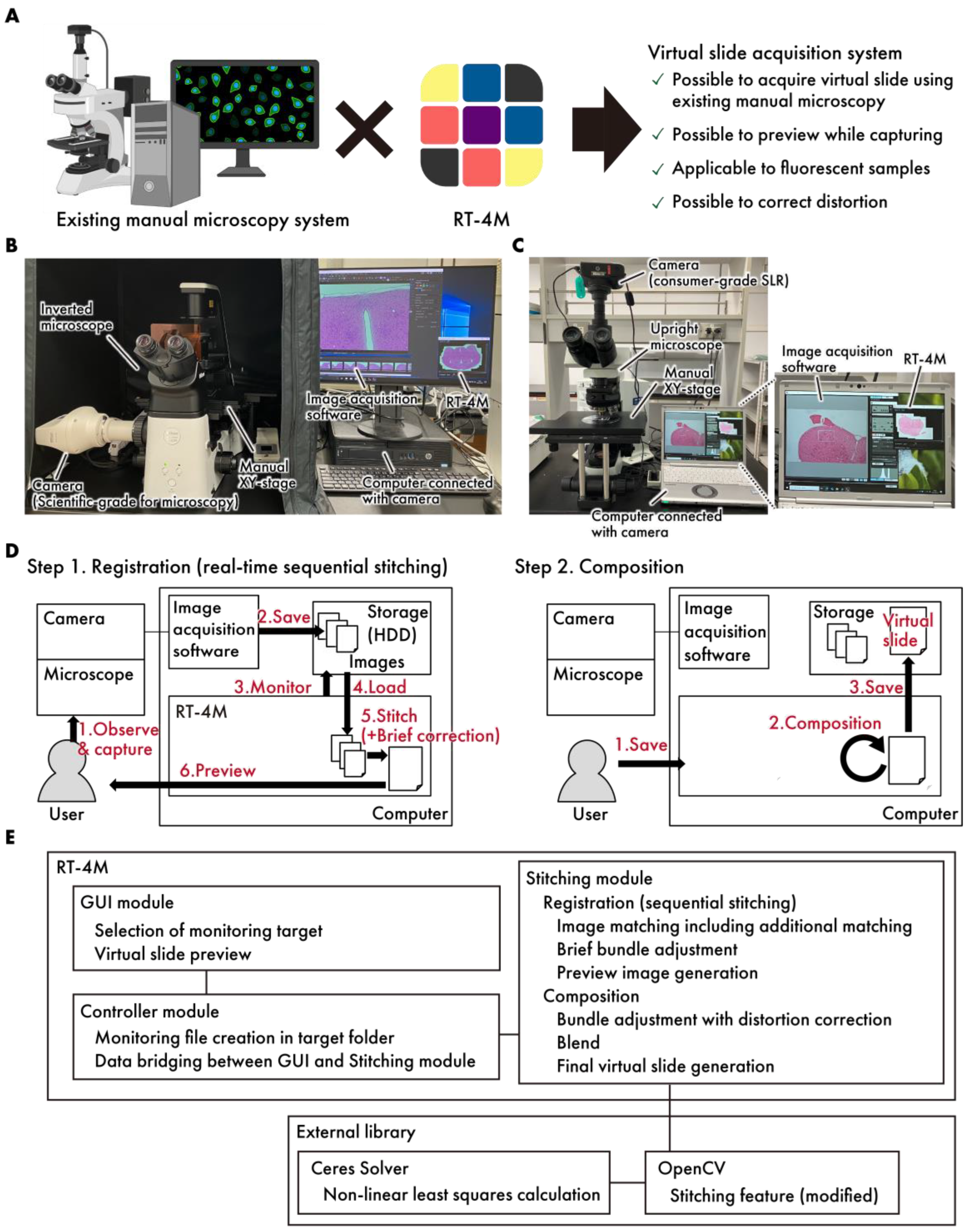
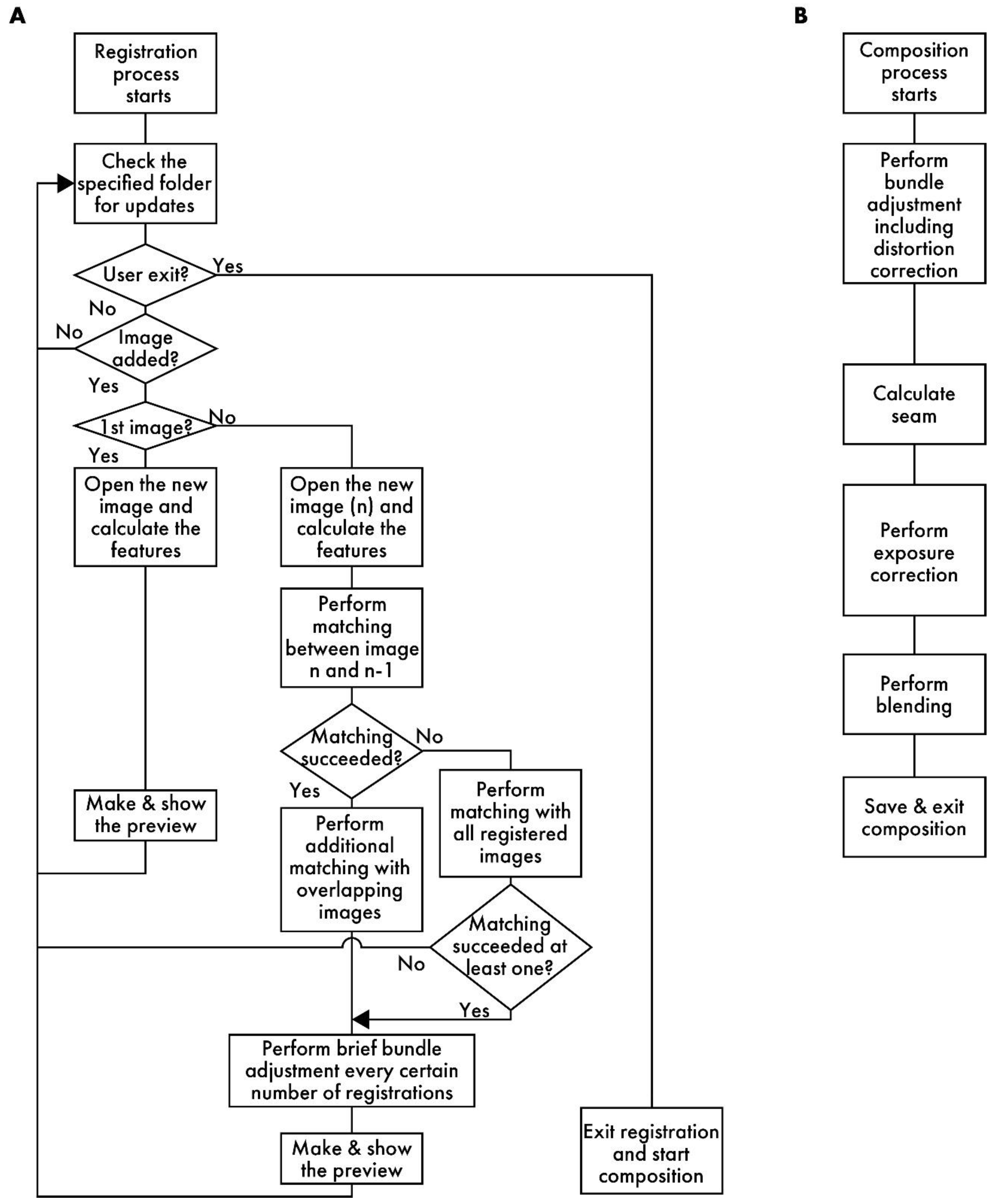


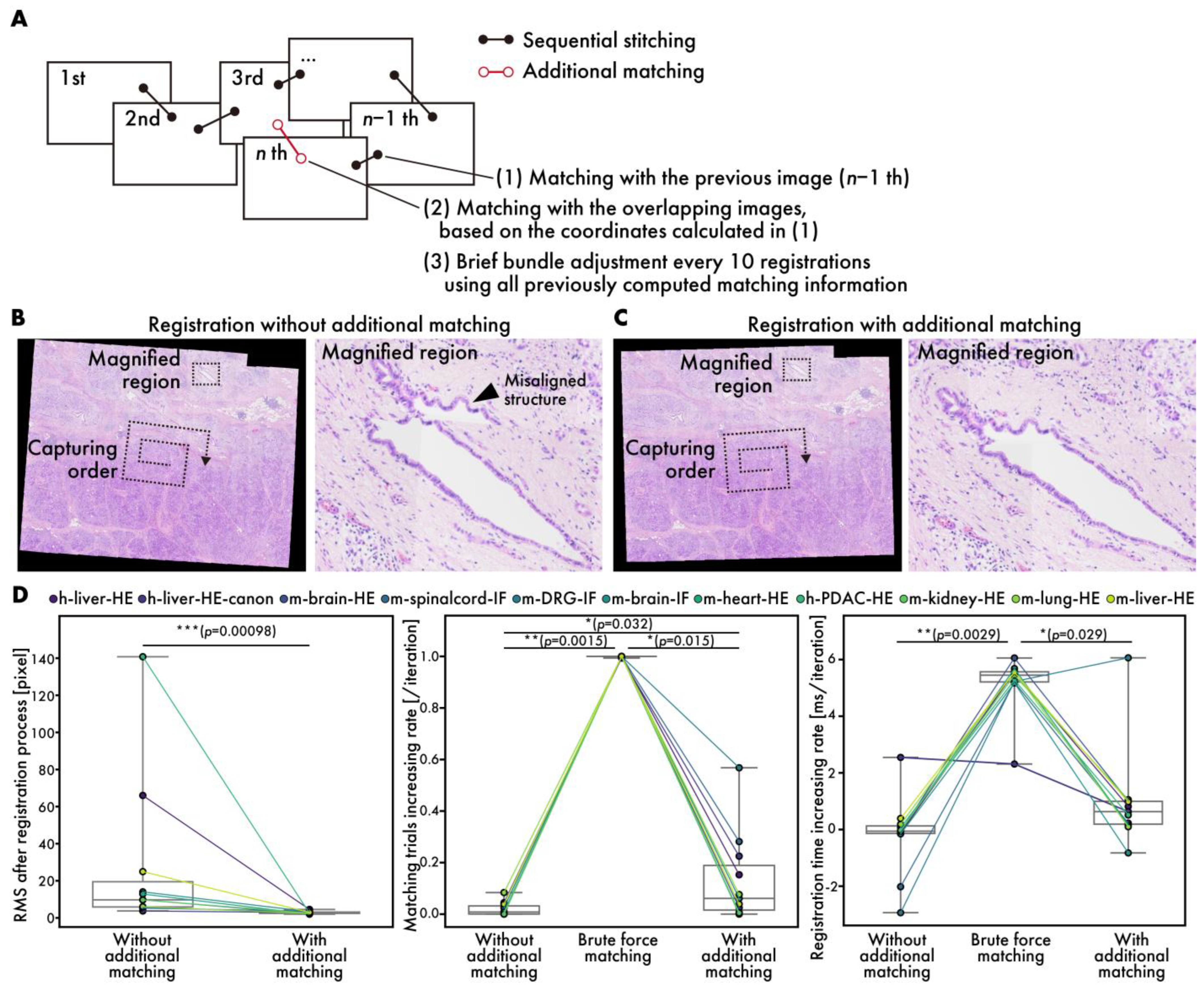
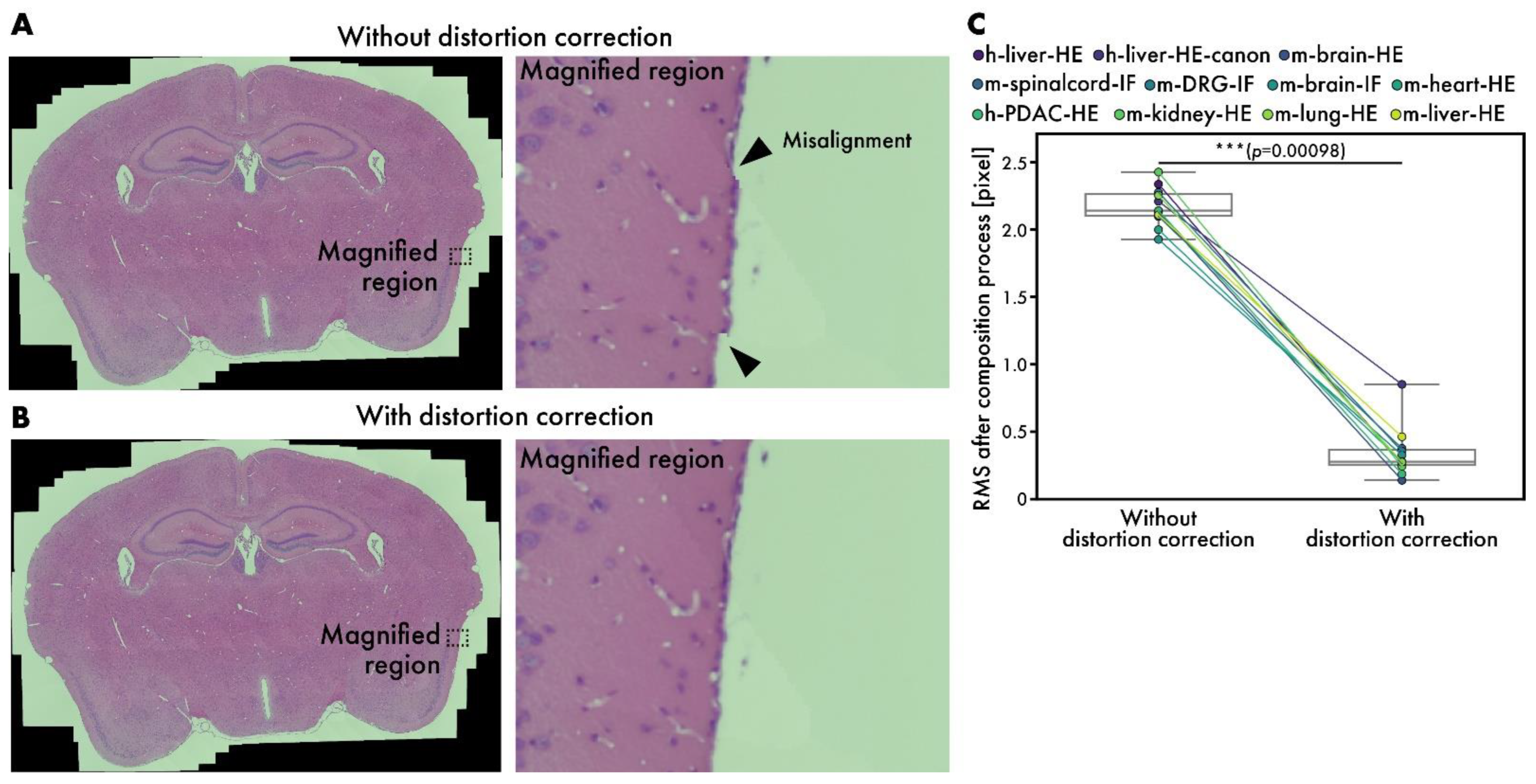
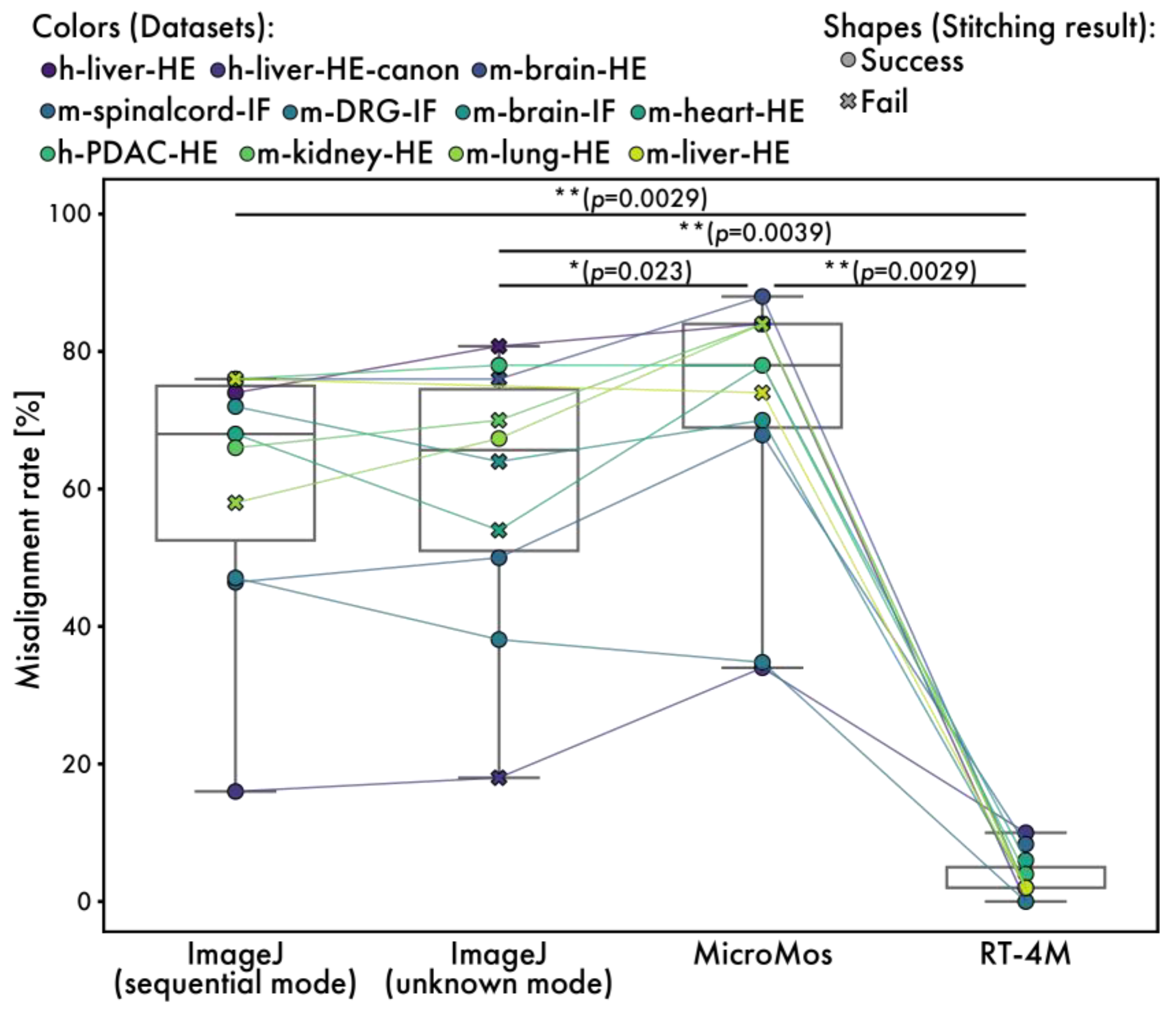
| Dataset Name | Species | Tissue | Imaging Method | Microscope | Camera | Exposure (ms) | Averaging | Number of Images | Dimension (Pixels) | Continuity |
|---|---|---|---|---|---|---|---|---|---|---|
| h-liver-HE | Human | Liver | Bright field | Nikon Eclipse Ts2R | Nikon DS-Ri2 | 7 | 1 | 59 | 1636 × 1088 | Yes |
| h-liver-HE-canon | Human | Liver | Bright field | Evident BX51WI | Canon EOS Kiss X7 | 1 | 1 | 37 | 5184 × 3456 | Yes |
| m-brain-HE | Mouse | Brain | Bright field | Nikon Eclipse Ts2R | Nikon DS-Ri2 | 0.5 | 1 | 154 | 1636 × 1088 | Yes |
| m-spinalcord-IF | Mouse | Spinal cord | Fluorescence | Nikon Eclipse Ts2R | Nikon DS-Ri2 | 400 | 1 | 25 | 1636 × 1088 | Yes |
| m-DRG-IF | Mouse | DRG | Fluorescence | Nikon Eclipse Ts2R | Nikon DS-Ri2 | 400 | 4 | 15 | 1636 × 1088 | Yes |
| m-brain-IF | Mouse | Brain | Fluorescence | Nikon Eclipse Ts2R | Nikon DS-Ri2 | 400 | 4 | 90 | 1636 × 1088 | Yes |
| m-heart-HE | Mouse | Heart | Bright field | Nikon Eclipse Ts2R | Nikon DS-Ri2 | 1 | 1 | 164 | 1636 × 1088 | Yes |
| h-pdac-mod-HE | Human | PDAC | Bright field | Nikon Eclipse Ts2R | Nikon DS-Ri2 | 1 | 1 | 320 | 1636 × 1088 | Yes |
| m-kidney-HE | Mouse | Kidney | Bright field | Nikon Eclipse Ts2R | Nikon DS-Ri2 | 0.4 | 1 | 164 | 1636 × 1088 | Yes |
| m-lung-HE | Mouse | Lung | Bright field | Nikon Eclipse Ts2R | Nikon DS-Ri2 | 0.4 | 1 | 80 | 1636 × 1088 | No |
| m-liver-HE | Mouse | Liver | Bright field | Nikon Eclipse Ts2R | Nikon DS-Ri2 | 1 | 1 | 908 | 1636 × 1088 | No |
| Dataset | Total Processing Time of Each Software (s) | |||
|---|---|---|---|---|
| ImageJ Sequential Mode | ImageJ Unknown Mode | MicroMos | RT-4M | |
| h-liver-HE | 46.2 | 957.4 (Fail) | 426.0 | 51.3 |
| h-liver-HE-canon | 226.9 | 2946.1 (Fail) | 1170.0 | 331.8 |
| m-brain-HE | 177.4 | 6750.7 (Fail) | 1260.0 | 161.0 |
| m-spinalcord-IF | 19.9 | 152.5 | 110.0 | 38.9 |
| m-DRG-IF | 12.4 | 50.2 | 57.0 | 30.0 |
| m-brain-IF | 66.5 | 1886.7 (Fail) | 713.0 | 111.0 |
| m-heart-HE | 119.5 | 6932.0 (Fail) | 2312.0 | 177.3 |
| h-pdac-mod-HE | 236.1 | 22,806.3 | 6671.0 | 561.1 |
| m-kidney-HE | 137.8 | 6312.6 (Fail) | 2225.0 (Fail) | 209.3 |
| m-lung-HE | 60.4 (Fail) | 1461.9 | 618.0 (Fail) | 117.7 |
| m-liver-HE | 13,338.7 (Fail) | (non-completion) | 21,414.0 (Fail) | 2183.4 |
Disclaimer/Publisher’s Note: The statements, opinions and data contained in all publications are solely those of the individual author(s) and contributor(s) and not of MDPI and/or the editor(s). MDPI and/or the editor(s) disclaim responsibility for any injury to people or property resulting from any ideas, methods, instructions or products referred to in the content. |
© 2025 by the authors. Licensee MDPI, Basel, Switzerland. This article is an open access article distributed under the terms and conditions of the Creative Commons Attribution (CC BY) license (https://creativecommons.org/licenses/by/4.0/).
Share and Cite
Mori, N.; Miyazaki, Y.; Oda, T.; Kida, Y.S. RT-4M: Real-Time Mosaicing Manager for Manual Microscopy System. Sensors 2025, 25, 2968. https://doi.org/10.3390/s25102968
Mori N, Miyazaki Y, Oda T, Kida YS. RT-4M: Real-Time Mosaicing Manager for Manual Microscopy System. Sensors. 2025; 25(10):2968. https://doi.org/10.3390/s25102968
Chicago/Turabian StyleMori, Nobuhito, Yoshihiro Miyazaki, Tatsuya Oda, and Yasuyuki S. Kida. 2025. "RT-4M: Real-Time Mosaicing Manager for Manual Microscopy System" Sensors 25, no. 10: 2968. https://doi.org/10.3390/s25102968
APA StyleMori, N., Miyazaki, Y., Oda, T., & Kida, Y. S. (2025). RT-4M: Real-Time Mosaicing Manager for Manual Microscopy System. Sensors, 25(10), 2968. https://doi.org/10.3390/s25102968






